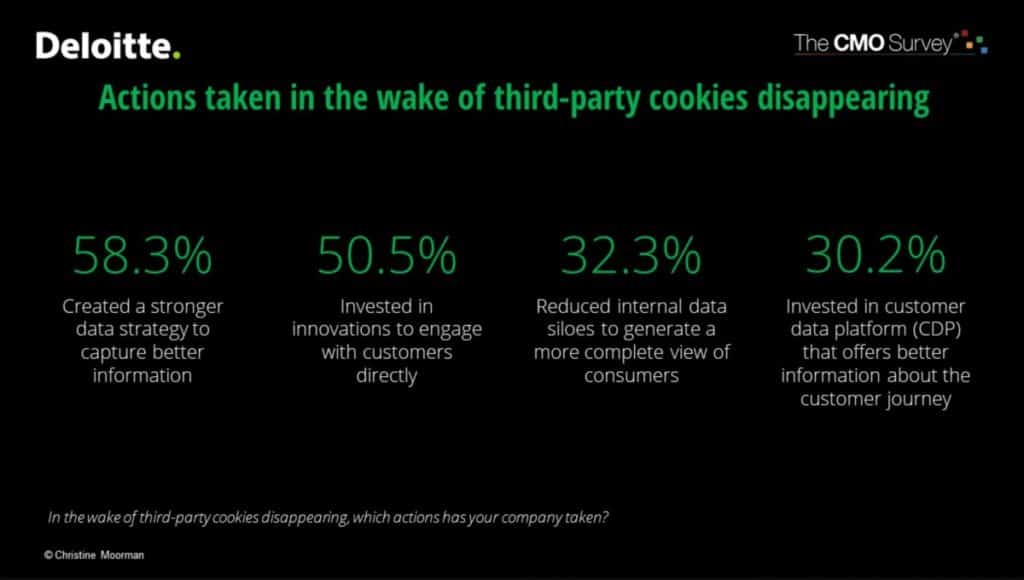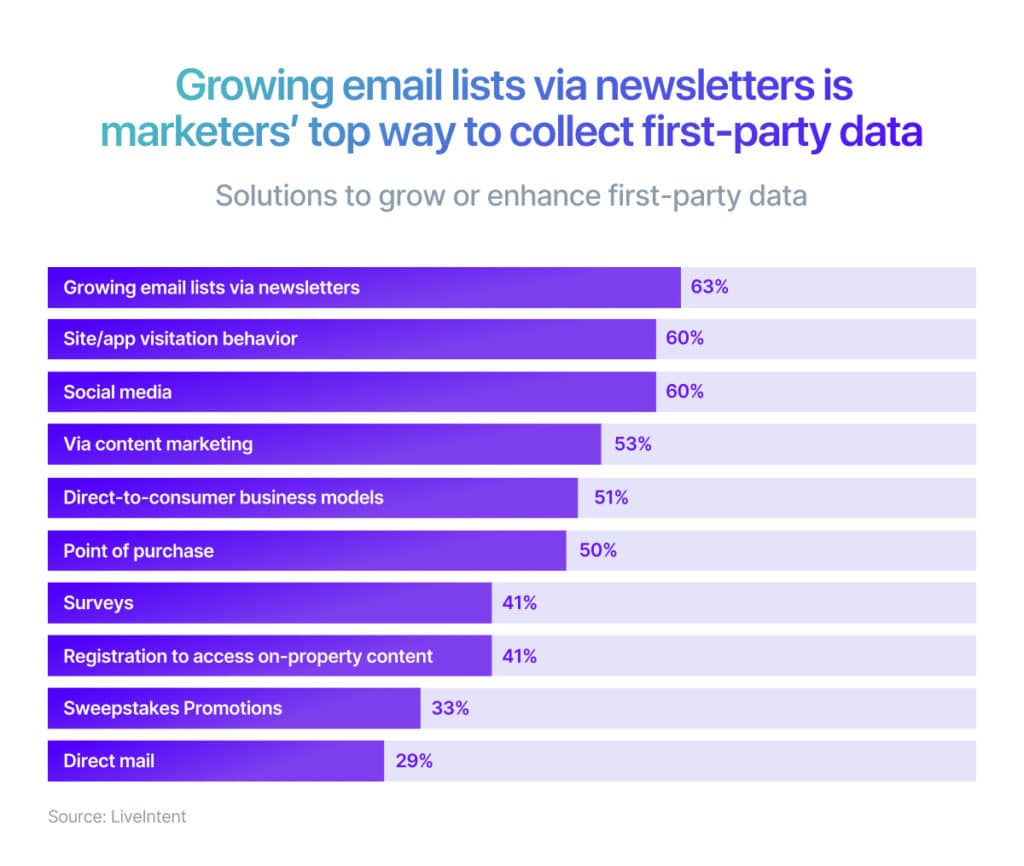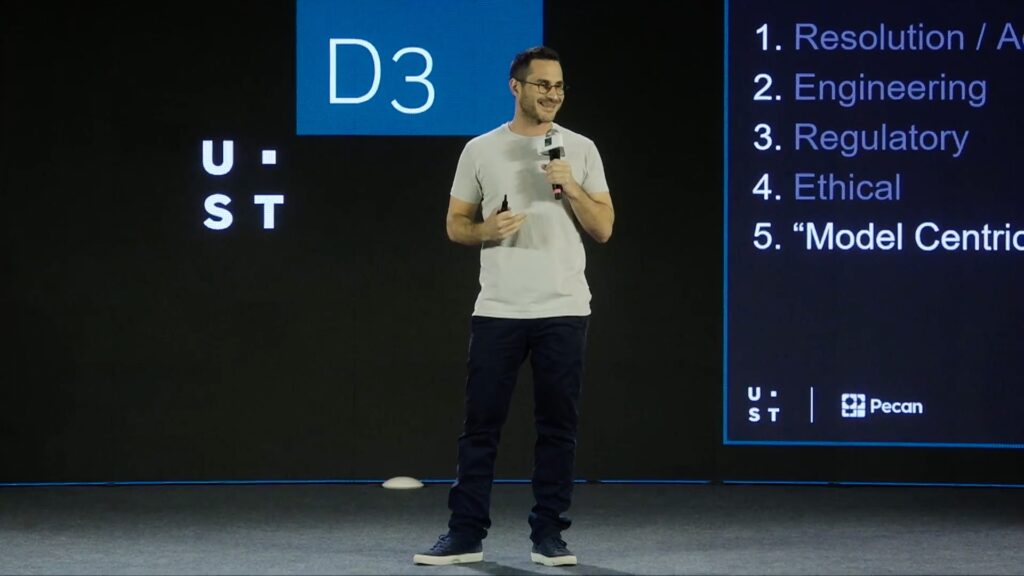In a nutshell:
- Google's plan to deprecate first-party data is now underway, so it's time to focus on first-party data strategies.
- Deloitte's survey shows CMOs are already preparing for the shift towards first-party data collection.
- Using first-party data for predictive analytics can lead to more personalized and effective customer interactions.
- Neil Hoyne emphasizes the importance of predicting customer lifetime value for building stronger relationships.
- Don't let changing deadlines derail your first-party data strategy – use the extra time to experiment and maximize business impact.
It’s like a roller-coaster diet: Yes to cookies! No to cookies! OK, yes, cookies. With yet another change to Google’s timeline for phasing out third-party cookies, marketing teams have to wonder how to move forward. Plans for collecting and using first-party data may now seem less urgent — but in reality, the delay offers invaluable time for more thoughtful, impactful strategy.
As CNET reported, Google has again pushed back its target date for beginning to block third-party cookies in Chrome, the world’s most popular web browser, to the second half of 2024.
This delay may not even be the last postponement, as Digiday discusses. So many stakeholders are involved in the new technologies intended to fill third-party cookies’ role. With so many cooks in the kitchen (or bakers?), the final deprecation of third-party cookies may take even longer.
In the meantime, the delay represents a huge opportunity to learn and experiment with the best methods for using first-party data. Don’t squander that data’s immense value by adopting less-than-optimal approaches. Instead, invest in strategies for gaining the greatest business value from your data.
Getting ready to use first-party data effectively
Deloitte’s recent survey of CMOs showed that many marketing leaders are already seeking solutions for first-party data collection and management in response to the impending loss of third-party cookies:
Data strategy, customer engagement, better data integration across teams, and new data management tools are certainly all critical to improved collection and usage of first-party data.
Where will the data come from? A study by LiveIntent showed marketers’ planned strategies for collecting additional first-party data:
It makes perfect sense to focus on building robust first-party data. That data is yours — an ongoing asset to your business you can use in many ways. Google recently highlighted three uses for first-party data:
- Strengthen relationships: use customer data to engage with them more deeply and offer personalized experiences
- Provide something of value for customers’ information: offer rewards for loyalty or individualized deals based on customers’ history
- Improve ad performance: boost ads’ relevance to viewers with first-party insights
These proposed ways to use first-party data are, well, OK, and they’d probably be somewhat rewarding. But there are also great approaches that are far more powerful.
The best ways to use first-party data are future-focused
Let’s take a closer look at these suggested uses for your first-party data. For example, yes, you could offer customers a personalized coupon or deal in exchange for their data.
But what if you used their data not just to send a generic deal of interest to all customers, but instead to generate a perfectly personalized offer that anticipates the rest of that customer’s journey with your business?
If you think about your first-party data solely through a historical, “BI-oriented” mindset, you might consider simply sending this customer your most popular offer as a way to launch your relationship with them. After all, if past data shows it was popular, customers probably like it.
But an AI-powered, predictive mindset offers a new perspective. You can use first-party data you’ve collected not only to look retrospectively at customers’ behavior patterns but also to obtain foresight into their likely future behavior and what they’ll want next.
You can send a customer an offer they won’t like. They’ll love it because you predicted their preferences more accurately.
Using your own data to shape long-term customer relationships
Neil Hoyne — chief measurement strategist at Google, author of Converted: The Data-Driven Way to Win Customers’ Hearts, and a recent Pecan webinar guest — is a huge fan of predicting customer lifetime value (LTV), among other key future-looking customer attributes.
During our webinar, Neil discussed how predicting LTV can optimize how you interact with customers and build stronger relationships:
Watch the full recorded event.
This longer-term, future-focused perspective on customer behavior is a much more powerful way to use your first-party data. You can decide which customer behaviors matter most to you. Maybe that’s customer lifetime value, or perhaps it’s churn, upsell/cross-sell, or conversion. Predictive models can reveal what customers are likely to do or prefer. You can then take action based on those reliable predictions.
What happened in the past can be interesting to ponder. But wouldn’t it be better to shape strategies and customer outreach based on what will happen in the future?
Don’t let changing deadlines derail your strategy for using first-party data
It might be tempting to use Google’s delay as an excuse to press pause on your first-party data efforts. But consider it not as a delay but as an extension, like when you got an extra day on a homework assignment in school.
This changing timeline is an opportunity to enhance your first-party data strategy. One key to owning your data destiny is experimenting now with new data collection and management approaches. But, just as importantly, the other key is adopting strategies to obtain maximum business impact from your new trove of first-party data.
Predictive analytics uses your first-party data to its greatest potential, even if you don’t think the data is completely ready. That’s especially true when you use a predictive analytics platform like Pecan that makes AI accessible to all business teams and their embedded data analysts, who know your business and its needs best.
Third-party cookies — who needs ‘em? With a proactive, predictive approach to your first-party data, you can exit the third-party roller coaster. Instead, enjoy steady, reliable foresight about your customers.
If you’re down with first-party data but not yet developing a predictive analytics strategy, we’ve got resources to help. First, check out our guide to The What and Why of Predictive Analytics for the basic concepts you need to know. Then, grab our hands-on workbook to evaluate how you can efficiently implement predictive analytics with your team.
Get in touch for a quick, easy use-case consultation. We’ll help you find the best way to get future-ready.





